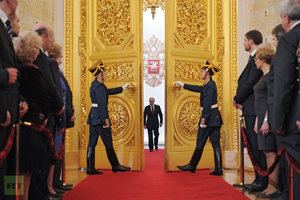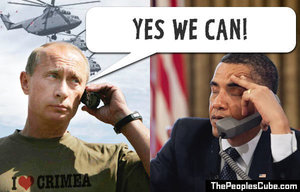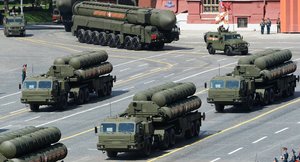Russia Checkmates US in Syria: Expect More Terrorism, Not Nuclear War
 If you happen to be a member of the ‘international community’ – i.e., if you live in North America, Europe or Australia/New Zealand – you may have noticed a subtle shift in recent years in what you ‘know’ about Russia and its president, Vladimir Putin. From being just another country that you might like to visit one day, Russia and its leader have been transformed into the source of much of the world’s problems.
If you happen to be a member of the ‘international community’ – i.e., if you live in North America, Europe or Australia/New Zealand – you may have noticed a subtle shift in recent years in what you ‘know’ about Russia and its president, Vladimir Putin. From being just another country that you might like to visit one day, Russia and its leader have been transformed into the source of much of the world’s problems.
From ‘Russian aggression in Europe’ to ‘annexing Crimea and fomenting civil war in Ukraine’ to ‘shooting down passenger planes’ to ‘hacking American democracy’ to ‘bombing innocent civilians and hospitals’ (and bunny rabbits) to ‘creating the European refugee crisis’ to having a monopoly on ‘state-sponsored doping’ and ‘supporting terrorists in Syria’, there doesn’t seem to be much that Russia hasn’t done to royally screw up the planet.
Of course, the astute reader will have noticed that most of these allegations come from American politicians, political pundits and newspapers.
In recent weeks, the level of anti-Russian vitriol coming out of places like the US State Department has reached such a pitch that we all might be excused for taking up yoga in anticipation of the moment when we must perform the necessary maneuver to kiss our collective arse goodbye in a global nuclear conflagration.
But the existential threat of a ‘hot war’ between Russia and the USA is more the stuff of nightmares and propaganda than reality. The reality is that the ‘exceptional’ USA is all out of options, including nuclear, when it comes to impeding Russia’s emergence as a major world power with global influence.

Over the course of the last 70 years, the USA and its allies have expanded their control (by one means or another and in one form or another) over most of the planet, with the notable exception of Russia and China. When the Soviet Union ‘fell’ in 1991, there was much jubilation and anticipation in the halls of power in America – jubilation that capitalism had triumphed in the ‘clash of civilizations’, and anticipation of a boon for American multi-national corporations as Russia’s vast energy resources would be ‘opened up’. During the 1990s, determined efforts were made by Western agents to seize control of Russia’s resources. But then along came Vladimir Putin.
Elected president in 1999, Putin spoiled the West’s looting spree, kicked out or assimilated the Russian oligarchs and their Western buddies, and progressively took back control of Russia, its resources and people. But securing the homeland was only the first step for the president with the ‘gunslinger’s gait‘. Putin also embarked on a quiet but profound modernization of the Russian military, all the while highlighting Russia’s interest in cooperating with the West and making nice with its politicians.
But Western predatory, militarized capitalism still had its sights on Russia, and the assumption in Washington was that Russia would eventually capitulate to the fait accompli of the New American Century. After all, US-led ‘globalization’ had made it all but impossible for any country to forge an independent path; even Russia with its vast oil and gas resources (on which Europe depends) couldn’t ignore the political reality of Washington’s imposing control.
If Russia needed a reminder, that was available in the form of ‘destabilization’ efforts by Western-backed ‘open society’ NGOs inside Russia and the obvious fact of Europe’s complete subservience to American dictates. In addition, US military prowess was being consistently shoved in Putin’s face with the continual expansion of NATO in Eastern Europe.

By 2013, and much to Washington’s frustration, Putin still held to the outdated concept of national sovereignty and Russia’s right to expand its influence and partnerships abroad, in particular in Syria and Iran. So Washington decided that a clear message to ‘get with the program’ was needed. That warning came in early 2014, in the form of a Western-backed coup d’état in long-term Russian ally and historical ‘buffer country’ against NATO, Ukraine.
An embarrassingly pro-Western client regime in Kiev was installed with the clear implication that Russia would soon be denied access to its historical Black Sea port in Sevastopol which facilitated Russian naval access to the Mediterranean. One of the goals of the US-sponsored coup in Ukraine was very likely to distract and delay Russia from taking an active role military in Syria, which had just a few months previously brokered a diplomatic deal to dispose of Syrian stockpiles of chemical weapons, thus preventing ‘shock and awe’ in Syria at the eleventh hour.
The Ukraine coup was a ‘bridge too far’ for Russia and when millions of ethnic Russians in Crimea recoiled at the idea of being ruled and abused by neo-Nazi stooges in Kiev, Russia facilitated an independence/accession referendum and Crimea, along with the Black Sea port of Sevastopol, became part of Russia with the support of 96% of voters. When ethnic Russians in eastern Ukraine reacted the same way as Crimeans, and demanded their independence and potential accession to the Russian Federation, the Russian government ensured that, at the very least, they had the means to defend themselves from Kiev’s onslaught.
Washington, of course, was outraged at the idea that any nation-state would dare challenge its ‘exceptional’ right to act globally as it sees fit, even when it meant royally screwing over that nation. But the point being made to Washington was that Russia was not only in a position to defend itself at home, but also its interests in the ‘near-abroad’.
That American supremacy is based on manipulation, coercion, threats and physical attacks against those who cannot defend themselves should be self-evident for any serious student of history. Yet the primary objective of the Western press has been to keep this fact from the wider public while touting American ‘humanitarianism’. When you have complete control of the airwaves, it’s easy to spin a turkey shoot against an inferior army, and the subsequent resource grab against a defenseless population, as liberating people in a war for freedom against a ‘brutal dictator’.
But even those few countries that avoided being turned into vassals of Empire, like Russia, were never expected by Washington to be in a position (or have the temerity) to directly challenge America’s ‘national interest’ in controlling the world. When Russia did so in Ukraine, the world got its first glimpse of the truth behind American supremacy, and from this moment on, the supreme confidence and wishful thinking of US policy-makers became their greatest weakness.

Faced with being checkmated in Ukraine and loudly denouncing Russia’s ‘annexation’ of Crimea, you might think that this was the opportunity for the USA to ‘nuke Russia’, or at least begin to prepare the ground for such. But apparently that wasn’t an option. Surely a more conventional military confrontation was possible and would succeed in putting Russia ‘back in its place’? A fleet of warplanes and ships sailing up the Black Sea to liberate Crimea should have solved the issue, right? It seems that that wasn’t ‘on the table’ either.
No indeed, what the brilliant minds in the Pentagon – with every fiber of US military muscle at their disposal – came up with in response to being slapped in the face over Ukraine, was lots of name-calling, baseless accusations and slander of every imaginable type against Russia. They even went so far as to shoot down a Malaysian airliner over eastern Ukraine and blame it on Putin himself, a desperately despicable move aimed at generating grist for the anti-Russia black propaganda mill.
Washington Outmaneuvered in Syria
By mid-summer 2015, relative calm had been restored in eastern Ukraine, but the conflict in Syria was still raging. Launched in 2011 by armed ‘rebels’ aiming to overthrow the Syrian government, the outbreak of this ‘civil war’ had nothing to do with the Syrian people. Instead, within a year, Syria was flooded with foreign mercenaries from dozens of countries, all very well-armed and organized.
Who, exactly, facilitated their move into Syria is still unknown, although it is known that many came from Libya which had been destroyed by NATO forces in 2011, and it seems rather coincidental that the ‘refugee crisis’, involving the transit of hundreds of thousands of people across the Syrian border, exploded around the same time.
In one of the most transparently farcical episodes of American foreign policy interventions (at least since 1979 in Afghanistan), the US State Dept. – which had been calling Assad a ‘brutal dictator’ for at least 2 years – declared the foreign jihadi army to be ‘freedom fighters’. By 2014, with the Syrian military holding its own and Assad winning re-election in a landslide victory that international observers agreed was free, fair and transparent, the fully formed and battle-ready ‘ISIS’ appeared and joined the US’ war against Syria and its people.
Born out of ‘al-Qaeda in Iraq’ under al-Zarqawi, which itself was partly a creation of the US military, ‘ISIS’ and ‘al-Nusra’ (aka ‘al-Qaeda in Syria’), all united under the black banner of pirated ‘Islam’, have been armed and protected by US forces in Syria and used to achieve the US imperial goal of taking control of the country. Mindbogglingly, fighting these same terror groups has been given as the reason for the US military presence (covert initially, but now overt) in Syria.
So it was not surprising that, throughout 2014 and most of 2015, as ISIS rampaged westwards across Syria and claimed responsibility for a string of brutal mass murders in Europe and the Middle East, the vaunted US-led coalition did nothing to check its advance. As a result, by the summer of 2015, the Syrian army was being hard-pressed by Washington’s terrorists, and the future of the Assad government was in doubt.
With a NATO bombing campaign (a rerun of Libya in 2011) to depose Assad looking increasingly likely, Russia chose to intervene to protect its strategic interests in the region and rid Syria of America’s jihadis. In doing so, Russia both called the US’ bluff that it was ‘fighting terrorists’ in Syria and removed any remaining doubt that the US and its ‘allies’ are, in fact, long-term sponsors of Islamic terrorists.
‘Hot war’ between US and Russia
So how far will this go? The suggestion that the Syrian conflict could ‘spiral out of control’ and end in a nuclear war between the USA and Russia is not credible, for several reasons. The people who direct US foreign policy are fundamentally sick people. Their overriding and insatiable lust is for wealth and the illusion of power it affords them. A global nuclear war would make that wealth and power unavailable to them because the majority of the people and infrastructure that provide it would be gone.
The only plausible scenario in which the US would launch a nuclear strike against Russia would be if the chickenhawks in Washington felt assured of their ‘first strike’ capability, i.e. where Russia could not strike back. It is widely accepted, even in the halls of power in the US, that this is not possible. But even if it were, the prelude to such an attack would undoubtedly involve severe aggression by the US against Russia because it would do so safe in the knowledge that it could nuke its inferior adversary at any time. As of yet, this hasn’t happened, indicating that any such action would threaten US hegemony.

In their confrontation over Syria, we have again seen no evidence that the US has this level of self-belief. In fact, the opposite is true. As already noted, in their verbal attacks and black propaganda against Russia, US politicians grow more hysterical by the day. Every imaginable slur is cast, and every one is provably false. This is not the behavior of a country that feels it holds all the cards, but rather one that feels it is about to lose, and lose big.
So what can we expect next from the USA? Recent noises out of the Pentagon suggest they are thinking about directly attacking the Syrian government and military. Whether or not they can actually do that with impunity is, however, highly doubtful. Having watched the way the US handles ‘regime change’ in countries like Iraq and Libya, Russia has no doubt anticipated such a scenario.
Russia has installed S-400 anti-aircraft missile systems at its Hmeimim Air Base in Latakia, northwestern Syria. This week an S-300 system was delivered further south to the Russian naval base at Tartus, to “ensure the safety of the naval base [there] and ships located in the coastal area”. These systems are designed to defend against aircraft, cruise and ballistic missiles and have a range of 250 and 400km.
I’ve suspected for a while that the Russians have installed more than just the above two missile systems in Syria. Just today, the Russian Defense Ministry confirmed my suspicion, warning the US that there are “numerous” S-200, S-300, S-400 and BUK air defense systems up and running in Syria, and that they will be used to protect both the Russian and Syrian servicemen manning them, as well as the servicemen distributing humanitarian aid across the country. “Therefore,” said Russian Defense Ministry spokesperson General Igor Konashenkov,
“Any missile or airstrikes on the territory controlled by the Syrian government will create a clear threat to Russian servicemen. Russian air defense system crews are unlikely to have time to determine in a ‘straight line’ the exact flight paths of missiles and then who the warheads belong to. And all the illusions of amateurs about the existence of ‘invisible’ jets will face a disappointing reality.”
So Russia has stationed similar systems in other areas of Syria, and some of them are under the control of the Syrian army. If the US chooses to attack the Syrian army, then it will be in a position to defend itself, i.e. US planes will be shot down. With its carefully crafted image as the ‘world’s one superpower’ – an image that must be kept intact, at all costs – the shooting down of even one US warplane would be a severe psychological blow to America.And this goes way beyond military prestige: one such blow too many might be enough to ‘shake market confidence’ and cause serious damage to the dollar as ‘global reserve currency’. For all their bluster and psychological derangement, the US ‘reality-creators’ do cautiously, intuitively remember, at every turn, to protect, reinforce and project that illusion of invincibility.
The Empire has no clothes
America’s whole schtick since 9/11 has been to ‘project’ its military power and thus deter, in advance, any adversaries from committing to military maneuvers that potentially run counter to its interests. Phrases like ‘force posture’ and ‘projecting force to outlying regions’ are sprinkled liberally throughout those infamous PNAC (Project for the New American Century) documents from the 1990s.
An American admiral recently brought the point home when he declared that the coastlines of Russia and China would no longer be ‘no-go zones’ for the US Navy. Where before the Pentagon had previously labeled such regions ‘A2/AD’ (‘anti-access/area denial’) – meaning, essentially, that its vessels and other military hardware are sitting ducks in those zones – henceforth the Pentagon considers them, for purposes of communication (i.e., propaganda directed at adversaries, and also the American public), to be very much accessible because, in his words:
“Have no doubt, the US Navy is prepared to go wherever it needs to go, at any time, and stay there for as long as necessary in response to our leadership’s call to project our strategic influence.”
In other words, in response to being checkmated in Syria, they are declaring that the US military can go anywhere it wants, and do anything it wants, not because it is actually capable of doing so but because it wants to be seen as being capable of it. In short, America must project the illusion of being all-powerful.
Russia is in the ascendancy now, so it can begin to dictate terms. Just yesterday, the Russian government announced that it was unilaterally withdrawing from a bilateral treaty with the US on disposal of plutonium from decommissioned nuclear warheads, citing repeated US violations of the deal. Not only that, Russia won’t recommit to the treaty until the US meets the following demands:
- Washington must reduce its military presence in NATO member-states to the number they were at the moment of signing the plutonium disposal agreement on September 1, 2000.
- Repeal of all sanctions against Russian regions, persons and companies introduced by the US over Russia’s response to the Kiev coup, while also paying compensation for damages caused by them, including the damages caused by the counter-sanctions that Russia was forced to impose on Western governments and companies.
Faced with these unpalatable realities, carefully crafted by superior Russian diplomacy and military strategy, Washington will probably resort to exploiting its jihadi army by supplying them with anti-aircraft ‘MANPADS’ in a futile attempt to create its much-desired ‘no-fly zone’ and achieve its objective of seizing control of Syrian resources.
But neither Russia or Syria are likely to back down in the face of blatant American bombast, and if one more Russian or Syrian aircraft is shot down by the West’s jihadis, open season will undoubtedly be declared on them. The result will be more wailing and gnashing of teeth, bluff, bluster and lies from Washington, and not much else.
So rather than fret over being wiped out in a nuclear war, perhaps we should be much more concerned about the prospect that, as they continue to be outsmarted and outgunned by Russia and its growing cadre of allies, the stewards of the crumbling American Empire, in a final desperate and futile attempt to retain control over their vassal states, their populations and resources, will lash out in all directions, creating years of chaos, misery and death for untold millions across the globe, including lots of ‘terror attacks’ in Europe, and even the US homeland, to distract the population from seeing the illusory nature of America’s power.
In contrast, a nuclear war to end it all quickly might eventually seem quite appealing.

No mention of gas pipelines and an unfounded assumption that the shooting down of Malaysian airliner was at the hands of the US. Otherwise a very interesting article.
Hi, no, not in this one, but I\’ve written about those aspects before, and am writing about the pipelines right now.
U.S. must be heavily working on a plan to create some bigger problem for Russia so that the Middle East which US love to death (literally, of course) is given back to them by Russians. Afterall they can not abondon Israel; who I believe controls the ''corporations'' that use US as its military force. Of course you'd know better.